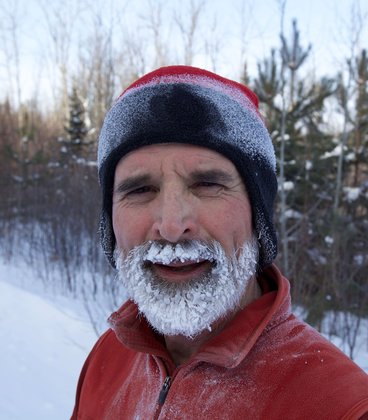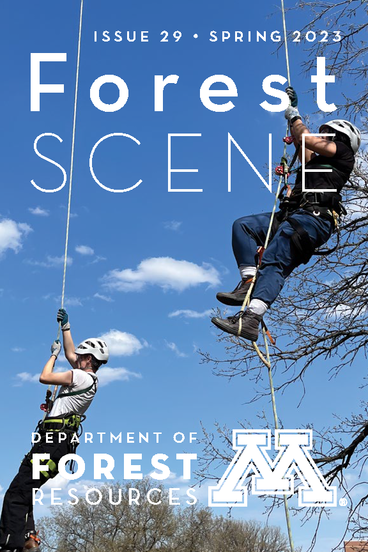
Ask Paul Bolstad what type of tree he would be, and you’ll first learn which types he’s not:
“I wouldn’t be a birch because I’m not that good looking,” he deadpans before breaking into a smile. “And I wouldn’t be an oak because I’m not that resilient,” he follows up thoughtfully.
Then, finally, his official answer: “I imagine I’d be something like a serviceberry – something that can live everywhere, does fine along the edges. And its foliage is pretty in the fall.”
That modest, practical choice is an apt metaphor for Bolstad’s overall ethos. Ever curious and adaptable, he’s had a remarkable career in forestry, natural resource management, and environmental science and policy that’s touched the lives of many. This June, he’s retiring after 30 years with the University of Minnesota.
Bolstad’s area of expertise is in ecosystem ecology and geographic information science, with a focus on land use and climate impacts on forest water and carbon cycles. He has taught classes on Geographical Information Systems (GIS), Global Positioning Systems (GPS), and geodesy. What’s more, his research has taken him across the world (he’s been a Principal Investigator or co-Principal Investigator on over $23 million in grants); he was a Fulbright scholar at the University of Natal in Durban, South Africa, where he developed important new curriculum; and in his career, he has authored more than 115 peer-reviewed publications.

Bolstad grew up in the foothills of California’s Central Valley, where he says he spent his time “goofing off outside, mostly in the woods.” He paid his way through school, starting first at a community college before transferring to the University of California, Berkeley, where he majored in Natural Resources. It was a sensible choice for someone looking to work outside and close to plants – and, he notes, to actually get paid.
From there, he hopped on opportunities as they came, following his gut from place to place, job to job, until, at the U of M, he found a close-knit community and stable work environment worth staying for. (Preceding that, Bolstad earned a masters in Forestry from North Carolina State University in 1984 and a Ph.D. in Environmental Monitoring from the University of Wisconsin, Madison, in 1990.) “I like to say that everybody I work with in the Department of Forest Resources takes their work seriously, but they don’t take themselves too seriously,” he says.
Bolstad started in research before he “stumbled into” teaching as a part of university jobs. Yet he grew to really appreciate that aspect of his work – especially how much he learned from his students. “It’s gratifying; if the class is big enough, there’s going to be students that are smarter than you,” he says.

Part of his ability to help students, he says, is understanding that there are so many forms of intelligence. Some students might face challenges in one area, yet have skills that help them thrive in other areas. Being mediocre at math, for example, doesn’t mean a person is ill fit for a career in natural resources science. There are other skills that are greatly needed in the field, too, such as communication and people management.
Regardless, Bolstad stresses that it’s vital to practice skills that don’t come naturally to you. “In order to do better in life, embrace your weaknesses and try to make them better,” he says. “If you’re not good at public speaking, try and get better at public speaking. If you’re not good at writing, try and get better at writing.” You don’t need to be an expert at everything, he says, but “things are richer the more skills you have.”
As an educator, Bolstad’s impact reaches beyond the students he’s actually had in class. He’s also the author and publisher of the remarkably affordable textbook GIS Fundamentals: A First Text on Geographic Information Systems. Now in its seventh edition, it’s been adopted by over 440 colleges and universities in more than thirty countries. The project came about when Bolstad was frustrated by the cost and quality of the course materials available for his introductory GIS students, so he wrote and published his own.
We at the Department of Forest Resources will greatly miss Paul Bolstad’s passion and creativity, and we are grateful for the many valuable contributions he has made to the field and our community. Luckily, Bolstad feels similar: “The department’s been a great place to work,” he says. “I’m really thankful that I’ve been able to work with such a great bunch of people.”

The Forest Scene newsletter is published biannually in the spring and fall, featuring stories and updates from the Department of Forest Resources. Readers can download issue 29 of Forest Scene as an interactive PDF that is fully tagged and compatible with most screen readers, or read the individual stories here in a web-based format:
- Department Message from Kristen Nelson
- ESPM Student Spotlight: Kylee Gregory
- FNRM Student Spotlight: Adam Langer
- From Student to Experts: Speaking With Your Audience – Communication tips from Forest Resources Professor and Extension Specialist Charlie Blinn
- Alumnus Spotlight: Steve Cook, Class of 1975
- Spring Semester Highlight: The Tree Ascension Club
Image 1 description: A man with a frost-covered beard stands outdoors. Besides the photo, text reads, "Faculty Retirement: Paul Bolstad. Forest Scene Issue 29, Spring 2023."
Image 2 description: Dr. Paul Bolstad smiles at the camera in winter. He's a Caucasian man whose full beard is covered in white frost. Bolstad wears a red winter coat and a red-and-blue hat. Behind him are snow-covered trees.
Image 3 description: Bolstad stands next to a row of young trees. He's much younger, with a brown beard, red baseball cap, a short-sleeved button-down shirt, khaki pants, and tennis shoes.
Image 4 description: Bolstad, in a baseball cap, shorts, bright yellow T-shirt, and knee-high galoshes, smiles while measuring a thick tree. It is summer and he is in a wooded area.
Image 5 description: Two student members of the Tree Ascension Club wearing safety gear, hanging in the air from ropes. Text reads, "Forest Scene Issue 29, Spring 2023. Department of Forest Resources." including a UMN logo.
